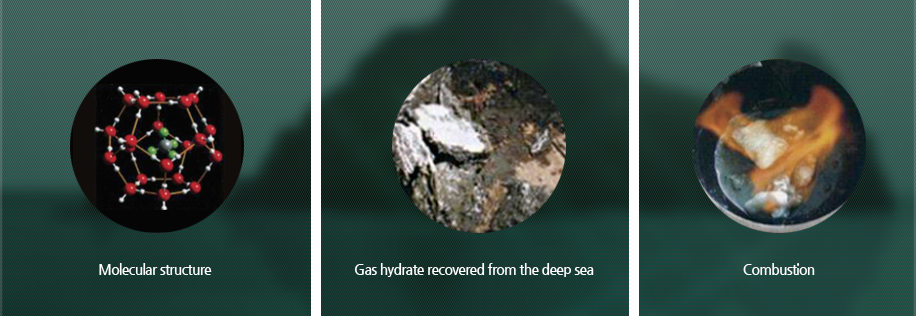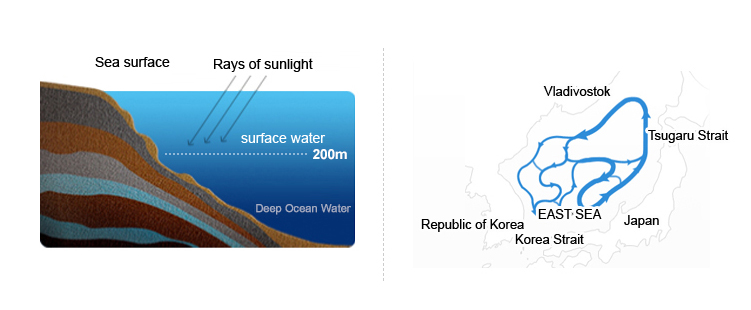Gas Htdrate
Gas hydrates are crystalline, ice-like substances composed of natural gas molecules, mainly methane, and are generally found in the deep sea at depths of more than 300 meters. They are called “fire ice” or “methane hydrate.” As they emit less carbon dioxide during combustion than coal or oil, they have been recognized as a clean energy source. Furthermore, they are also considered “indicative” resources as they indicate the presence of oil resources in a particular region.
It is estimated that gas hydrate reserves at a depth of 1,500 meters near the coastal waters of Ulleungdo and Dokdo amount to an equivalent of about 600 million to 2 billion tons of liquefied natural gas (LNG). This quantity could supply Korea for 30 to 100 years and create an import substitution effect reaching KRW 252 trillion.
(Sources: Nam Seong-hyon and Kim Yoon-bae, 2013)

< Sources: Dokdo Academy Textbook >
Phosphorites
Phosphorites are found in undersea volcanoes and mountains and on the ocean floor and continental slopes near the continental shelf. In the East Sea, at a depth of 500 to 1,000 meters, there is estimated to be more than 200 million tons of phosphorites, which could satisfy domestic demand for more than 50 years.
On the Korean continental slope to the north of Dokdo, phosphorites are exposed on the sea bed, and are made up of 30 percent phosphorous pentoxide (P2O5). The thickness of the phosphorous strata is about 20 meters, and is estimated to be of significant economic value.
Phosphorous is a mineral that can be used as raw or basic material for chemical-free natural fertilizer, and domestic demand for phosphor-based materials stands at about 1.52 million tons per year. Currently, Korea is wholly dependent on imports of such materials.
(Sources: Nam Seong-hyon and Kim Yoon-bae, 2013)
Deep ocean water

Location of deep ocean water in the East Sea coast and belt
< Sources: www.panablu.co.kr >
Deep ocean water is a specialized resource that has significant development potential in the East Sea, where the water is deep and continental slopes are steep. It is rich in various minerals and nutrients and free of bacteria, making it particularly favored as a high value added marine resource that can be utilized in various fields, including food, health, beauty, agriculture, fisheries, tourism, and energy. Currently (2013), there are only five countries with access to deep ocean water—the Republic of Korea, the United States, Japan, Norway, and Taiwan.
In the East Sea, the water reaches a depth of more than 200 meters at about 10 to 20 kilometers from the coast. Therefore, Ulleungdo and the East Sea are favorably situated for the development of deep ocean water resources.
In December 2004, Ulleung-gun (county) installed an intake tube in Hyeonpo-ri, Buk-myeon, with which it succeeded in extracting deep ocean water. In 2005, based on this source of deep ocean water, it created a food brand called “Shimhaewon,” whose first commercialized product was high-quality salts. In 2011, it began mass producing a brand of drinking water called “Cheongara (Korean for ‘blue water’).”
In 2008, Gyeongsangbukdo established the “Basic Plan for the Development of Deep Ocean Water in Gyeongsangbukdo,” which is currently underway. In the province, Uljin is the center of deep ocean water research and development, which is being carried out with the goal of determining how best to utilize it in the production of health foods and supplements and the cultivation of marine products.
(Sources: Nam Seong-hyon and Kim Yoon-bae, 2013)
References
- Gyeongsangbukdo, 2010, Dokdo Series
- Nam Seong-hyon and Kim Yoon-bae, 2013, “East Sea, A question on the future of the Sea,” Idam Books
- Dokdo Academy textbook
- Panablu (http://www.panablu.co.kr)
- KIGAM Geological Museum (http://museum.kigam.re.kr)